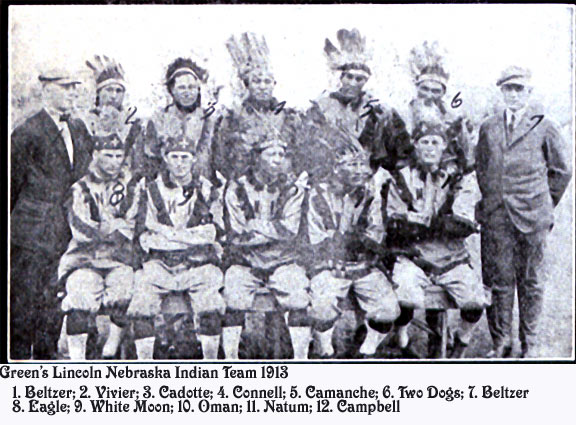
Buck played football and baseball for the University of Nebraska. In 1909 he was the captain of both the Husker football and baseball teams. Nebraska football opened a new venue in 1909. Before 1909 they played on Antelope Field at the "M" Street park. (now called Antelope Park). In 1909 they moved to Nebraska Field on campus. They tied South Dakota and Iowa, lost to Minnesota, Kansas and Haskell and beat Knox, Doane and Denver for a 3-3-2 record.
In the summer of 1908 or 1909 he formed a travelling team called the Oxford Indians from Oxford Nebraska. He hoped to have the same success as Guy Green did with his Green's Nebraska Indians team. The team recruited a few Sioux players but relied mainly on white players. He started his professional career in his hometown of Grand Island as player/manager for the Grand Island Collegians in the Nebraska State League in 1910. He was 22 years old. He played in 105 games and averaged .205. He played third base and some shortstop.
At the end of the season his contract was purchased by the Philadelphia Athletics for $300.00. When he did not make the Athletics in 1911 he joined Green's Nebraska Indians as a player. He bought the team from Guy Green in either 1911 or 1912.
In 1913 he was the coach/manager of the Green's Lincoln Nebraska Indian Team. This was an independent team which barnstormed the midwest during the season.

The team did well for a number of years. World War I then changed everything. Travel was difficult. The newspapers reduced their coverage of the travelling teams. In 1917 the team folded.
The Nebraska State League folded in 1915. In 1922 Buck and a number of other baseball supporters restarted the NSL. One of the problems was that Lincoln did not have a suitable baseball diamond. The "M" Street (Antelope Park) Park burned down and the city had not replaced it. Buck acquired land near 2nd and "P" and built a ball diamond. He named it Landis Field after the commissioner of baseball. He managed the team to a second place finish in both halves of the split season.
He returned in 1923 with a strong team. They won the NSL championship by three games over Norfolk. Buck then sold Pid Purdy and Fred Conkey to the White Sox for a tidy sum of money.
In 1924, Lincoln was offered the chance to return to the Western League. Sioux City was in financial difficulty and the franchise wanted to relocate to Lincoln. The trouble was that Buck owned the class "D" rights to the Lincoln territory. In a set of interesting moves Lincoln was declared a class "A" town, Buck was locked out of the opportunity to acquire the class "A" team and his ballpark was acquired so the new owners of the Western League franchise could host their games in the park. The only consolation for Buck was that the Lincoln team was terrible in 1924 finishing 46 and a half games out of first. Lincoln was a bottom dweller through the 1927 season. After the 1927 season the dropped out of the Western League.
Buck Beltzer then went on to become president of the Grand Island Trust Company in Grand Island Nebraska.
Husker Diamond was built in the forties as the home of Nebraska baseball. The field was changed to Buck Beltzer Stadium in 1979 after a donation from Buck's children for stadium upgrades including expanded seating, a press box and dugout improvements.
He died in September of 1959 at age 71.
Nebraska Minor League Baseball Home